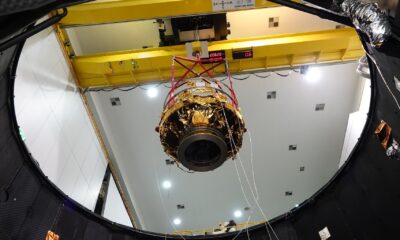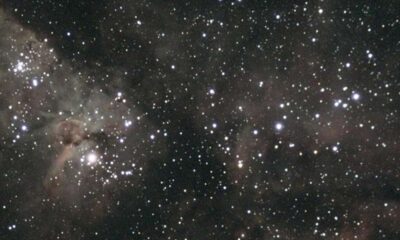Science
Solar Orbiter Unlocks Secrets of Sun’s Polar Magnetic Field

A groundbreaking study utilizing data from the European Space Agency’s Solar Orbiter has provided scientists with their first glimpse of the sun’s polar magnetic field in motion. The findings, detailed in The Astrophysical Journal Letters, reveal critical insights into the dynamics of the sun’s magnetic activity, which operates on an approximately eleven-year cycle.
The sun’s magnetic activity is governed by complex plasma flows that circulate across its surface, generating magnetic field lines that travel from the equator to the poles. While previous observations from Earth and other space probes have offered limited perspectives, the Solar Orbiter’s unique trajectory allows for a more comprehensive view of the polar regions. Launched in February 2020, the spacecraft recently ventured out of the plane where most space probes orbit, enabling it to capture unprecedented data.
Revolutionary Insights from New Data
The study, led by researchers at the Max Planck Society (MPS) and co-authored by director Sami Solanki, analyzed data from the Solar Orbiter’s Polarimetric and Helioseismic Imager (PHI) and Extreme-Ultraviolet Imager (EUI). The PHI data, collected on March 21, 2025, alongside EUI data from March 16 to March 24, provided essential information about the direction of plasma flows and the magnetic field at the sun’s south pole.
For the first time, the researchers revealed details about the supergranulation and magnetic network in this region. Supergranules are large cells of hot plasma that cover the sun’s surface, measuring two to three times the size of Earth. The study found that these supergranules facilitate the movement of magnetic field lines, creating a complex web of magnetic fields.
Unexpectedly, the data showed that the magnetic field is drifting toward the poles at an average speed of approximately 10 to 20 meters per second, a rate comparable to that observed at lower latitudes. This finding contradicts earlier studies conducted in the ecliptic plane, which reported much slower magnetic movements in high polar regions.
Implications for Solar Research
The findings from the Solar Orbiter are significant for understanding the sun’s global plasma and magnetic circulation. Research group leader Lakshmi Pradeep Chitta emphasized that the supergranules at the poles act as tracers, providing visibility into the polar component of the sun’s eleven-year magnetic cycle.
Despite these advances, uncertainties remain regarding whether the sun’s global magnetic conveyor belt slows down near the poles. The current data represent a mere snapshot of the solar cycle, necessitating further observations over extended periods to draw more definitive conclusions.
As the Solar Orbiter continues its mission, scientists anticipate that ongoing data collection will unravel more mysteries surrounding the sun’s magnetic field and its broader implications for solar activity and space weather. This research marks a pivotal step in enhancing our understanding of the sun’s intricate behavior, which has profound effects on the solar system and Earth’s own magnetic environment.
More detailed findings can be accessed in the publication by Chitta et al., titled “Supergranulation and Poleward Migration of the Magnetic Field at High Latitudes of the Sun.”
-

 Technology4 months ago
Technology4 months agoDiscover the Top 10 Calorie Counting Apps of 2025
-

 Health2 months ago
Health2 months agoBella Hadid Shares Health Update After Treatment for Lyme Disease
-

 Health3 months ago
Health3 months agoErin Bates Shares Recovery Update Following Sepsis Complications
-

 Technology4 weeks ago
Technology4 weeks agoDiscover 2025’s Top GPUs for Exceptional 4K Gaming Performance
-

 Technology2 months ago
Technology2 months agoElectric Moto Influencer Surronster Arrested in Tijuana
-

 Technology4 months ago
Technology4 months agoDiscover How to Reverse Image Search Using ChatGPT Effortlessly
-

 Technology4 months ago
Technology4 months agoMeta Initiates $60B AI Data Center Expansion, Starting in Ohio
-

 Technology4 months ago
Technology4 months agoRecovering a Suspended TikTok Account: A Step-by-Step Guide
-

 Health4 months ago
Health4 months agoTested: Rab Firewall Mountain Jacket Survives Harsh Conditions
-

 Lifestyle4 months ago
Lifestyle4 months agoBelton Family Reunites After Daughter Survives Hill Country Floods
-

 Technology3 months ago
Technology3 months agoUncovering the Top Five Most Challenging Motorcycles to Ride
-

 Technology4 months ago
Technology4 months agoHarmonic Launches AI Chatbot App to Transform Mathematical Reasoning




















